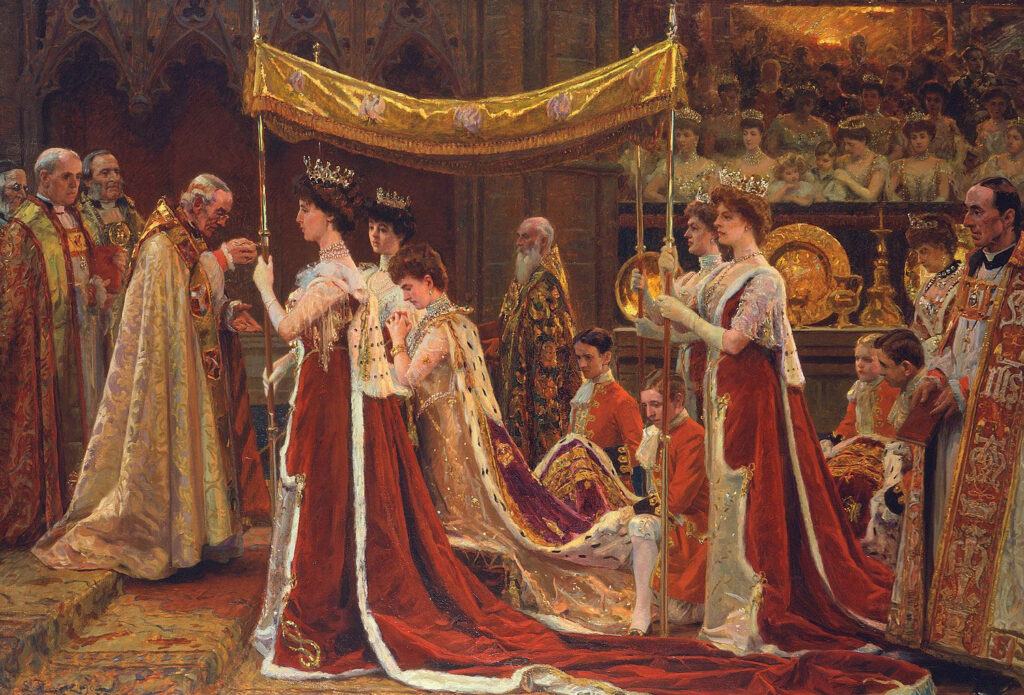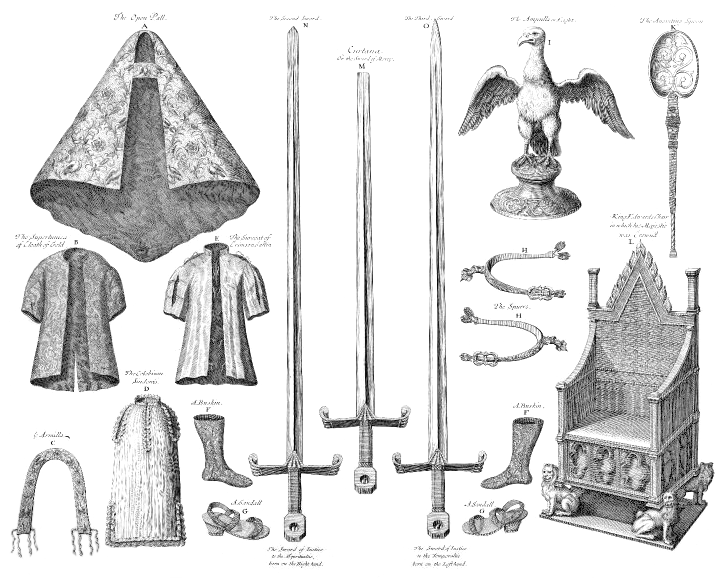In this not-so-romantic blog, I’ll be exploring my favourite coronation object … and it might not be what you expect! Today we ask the question: What is the Coronation Spoon?
This year marks the first coronation in Britain for 70 years, so it’s a great time to find out more about what’s involved. After all, it’s a pretty unusual event and there’s lots to it.
What do you think of when you picture a coronation? You might imagine a crown being placed on the monarch’s (king or queen’s) head.
But my favourite object involved in a coronation is … a spoon.

It’s called the Coronation Spoon (or Anointing Spoon), to give it a fancy name.
You might be thinking, “A spoon!? That can’t be right!”
But it’s a very special spoon, and I’m going to explain why.
IT’S ONE OF THE CROWN JEWELS
Have you heard of the Crown Jewels? What do you think of?
Maybe gold, diamonds … and of course jewel-encrusted crowns.
The Crown Jewels are made up of more than 100 objects and over 23,000 gemstones. They’re important treasures which belong to the nation and are kept safe and secure at the Tower of London.
Fun fact: The Crown Jewels were previously kept at Westminster Abbey but they had to be moved because of the many attempted (sometimes successful!) robberies.

Within the Crown Jewels are a special set of objects called the Coronation Regalia. These objects are used at coronations, each representing the different powers and responsibilities of the monarch. They include things like the orb and sceptres, as seen in the image above.
You might guess from its name that the Coronation Spoon is part of the Coronation Regalia, which means it’s one of the Crown Jewels too!
Do you think it might be solid gold? Well, it’s actually made from silver with a very thin layer of gold on top. However, I would argue it’s still one of the most valuable objects, and I’ll explain why.
It’s the oldest object in the Coronation Regalia
The spoon is first recorded at Westminster Abbey in 1349, and even then it’s described as being of ‘antique forme.’ It’s likely over 800 years old!
Not only that, but the spoon is a survivor.
In 1642, King Charles I’s conflicts with Parliament led to the English Civil War … and eventually getting his head chopped off (gulp!). As there was no more king, Oliver Cromwell, Lord Protector and the Leader of the Parliamentarians, decided to sell off the Crown Jewels, with most of the gold melted down.
Luckily enough, the spoon was sold rather than melted. It was bought for 16 shillings by Clement Kynnersley, who had been in charge of Charles I’s wardrobe.
When the monarchy was restored and King Charles II came to the throne, Kynnersley returned the spoon and it was used at the new king’s coronation.
(As a side note, this was also when the small pearls were added.)

Charles II had a problem in that everything else was lost and had to be remade, making most of the Coronation Regalia as we know it about 350 years old.
But it also means the spoon is the one object which links all coronations back through the ages to medieval monarchs.
Maybe even all the way back to King Henry II’s coronation in 1154 – 869 years before King Charles III was crowned.
To learn more about the English Civil War, check out this other not-so-romantic blog!
It’s used alongside A GOLDEN EAGLE
In case you’re wondering, the Coronation Spoon was never made for eating or stirring.
We can tell this because the bowl is divided into two sections and because it’s so long – 26.7cm, which is almost the length of a school ruler. Imagine trying to eat cereal with a spoon that long!
This shows that the Coronation Spoon has always had a ceremonial purpose. And when we pair it with the Ampulla, this can give us a better idea of what that purpose is.

The Ampulla, which is made from solid gold, is shaped like an eagle with outstretched wings, and is a bit like a flask. Its head unscrews so it can hold a special liquid, which is poured out of the beak of the eagle and into the Coronation Spoon.
Before we continue, it might be helpful to explain that a coronation is a religious, Christian ceremony.
It’s used at the most sacred moment of the coronation
The special liquid kept in the Ampulla is holy oil. The recipe is kept secret, but it contains oil from orange flowers, jasmine, cinnamon and roses.
During a coronation, the archbishop (an important priest in charge of the service) pours the oil from the Ampulla into the spoon and then uses it to anoint the monarch’s head, heart and hands.
This part of the coronation service is called the anointing and is a religious blessing.
Anointing symbolises that the monarch has been chosen and set apart by God for this special role and to lead their people.
This is the only part of a coronation that those watching are not allowed to see. During Queen Elizabeth II’s anointing in 1953, a golden canopy was used to shield her from view. It also wasn’t filmed or photographed.

Similarly, this image shows Queen Alexandra kneeling under a canopy, about to be anointed.
A special anointing screen was made for the coronation of King Charles III to allow him privacy during this moment of the ceremony.
The tradition of anointing dates back to the Old Testament, where King Solomon was anointed by Zadok the Priest.
Because it’s the most sacred part of the ceremony, it takes place before the monarch receives all the Coronation Regalia, and before they’re crowned.
The crowning itself is near the end of the ceremony and infact a monarch is crowned to show that they have been anointed!
The most interesting of the Regalia … or just a spoon?

So, did you know that the oldest object in the Coronation Regalia is a spoon?
Or that there’s a spoon amongst the Crown Jewels?
Or that it survived being melted down?
Or that it’s used for the most sacred part of a coronation ceremony (the anointing)?
Forget the crown! It might not look as fancy, but of all the coronation objects, to me, the Coronation Spoon is one of the most important and fascinating.
But if you have your own favourite coronation object you’d like to share, then pop it in the comments below. I’d love to hear them!
WHAT TO READ NEXT
If you’ve enjoyed this not-so-romantic blog then here are some others you should read next!
